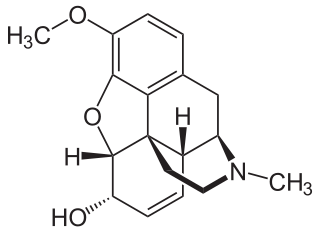The oxoglutarate dehydrogenase complex (OGDC) or α-ketoglutarate dehydrogenase complex is an enzyme complex, most commonly known for its role in the citric acid cycle.

Ethylmorphine is an opioid analgesic and antitussive.

Codeine is an opiate and prodrug of morphine mainly used to treat pain, coughing, and diarrhea. It is also commonly used as a recreational drug. It is found naturally in the sap of the opium poppy, Papaver somniferum. It is typically used to treat mild to moderate degrees of pain. Greater benefit may occur when combined with paracetamol (acetaminophen) or a nonsteroidal anti-inflammatory drug (NSAID) such as aspirin or ibuprofen. Evidence does not support its use for acute cough suppression in children or adults. In Europe, it is not recommended as a cough medicine in those under 12 years of age. It is generally taken by mouth. It typically starts working after half an hour, with maximum effect at two hours. Its effects last for about four to six hours. Codeine exhibits abuse potential similar to other opioid medications, including a risk of habituation and overdose.
In enzymology, a codeinone reductase (NADPH) (EC 1.1.1.247) is an enzyme that catalyzes the chemical reaction
In enzymology, a 4-methoxybenzoate monooxygenase (O-demethylating) (EC 1.14.99.15) is an enzyme that catalyzes the chemical reaction
In enzymology, a flavanone 3-dioxygenase (EC 1.14.11.9) is an enzyme that catalyzes the chemical reaction
In enzymology, a flavonol synthase is an enzyme that catalyzes the following chemical reaction :
In enzymology, a gibberellin 2beta-dioxygenase (EC 1.14.11.13) is an enzyme that catalyzes the chemical reaction
In enzymology, a gibberellin-44 dioxygenase (EC 1.14.11.12) is an enzyme that catalyzes the chemical reaction
In enzymology, a hyoscyamine (6S)-dioxygenase (EC 1.14.11.11) is an enzyme that catalyzes the chemical reaction
In enzymology, a peptide-aspartate beta-dioxygenase (EC 1.14.11.16), a member of the alpha-ketoglutarate-dependent hydroxylases superfamily, is an enzyme that catalyzes the chemical reaction
In enzymology, a pyrimidine-deoxynucleoside 1'-dioxygenase (EC 1.14.11.10) is an enzyme that catalyzes the chemical reaction

In enzymology, a sterol 14-demethylase (EC 1.14.13.70) is an enzyme of the Cytochrome P450 (CYP) superfamily. It is any member of the CYP51 family. It catalyzes a chemical reaction such as:
In enzymology, a decylhomocitrate synthase (EC 2.3.3.4) is an enzyme that catalyzes the chemical reaction

In enzymology, a homocitrate synthase (EC 2.3.3.14) is an enzyme that catalyzes the chemical reaction

In enzymology, a tryptophan transaminase is an enzyme that catalyzes the chemical reaction
(Histone-H3)-lysine-36 demethylase (EC 1.14.11.27, JHDM1A, JmjC domain-containing histone demethylase 1A, H3-K36-specific demethylase, histone-lysine (H3-K36) demethylase, histone demethylase, protein-6-N,6-N-dimethyl-L-lysine,2-oxoglutarate:oxygen oxidoreductase) is an enzyme with systematic name protein-N6,N6-dimethyl-L-lysine,2-oxoglutarate:oxygen oxidoreductase. This enzyme catalyses the following chemical reaction
Thebaine 6-O-demethylase (EC 1.14.11.31, T6ODM) is an enzyme with systematic name thebaine,2-oxoglutarate:oxygen oxidoreductase (6-O-demethylating). This enzyme catalyses the following chemical reaction
DNA oxidative demethylase (EC 1.14.11.33, alkylated DNA repair protein, alpha-ketoglutarate-dependent dioxygenase ABH1, alkB (gene)) is an enzyme with systematic name methyl DNA-base, 2-oxoglutarate:oxygen oxidoreductase (formaldehyde-forming). This enzyme catalyses the following chemical reaction
Christopher Joseph Schofield is a Professor of Chemistry at the University of Oxford and a Fellow of the Royal Society. Chris Schofield is a professor of organic chemistry at the University of Oxford, Department of Chemistry and a Fellow of Hertford College. Schofield studied functional, structural and mechanistic understanding of enzymes that employ oxygen and 2-oxoglutarate as a co-substrate. His work has opened up new possibilities in antibiotic research, oxygen sensing, and gene regulation.





